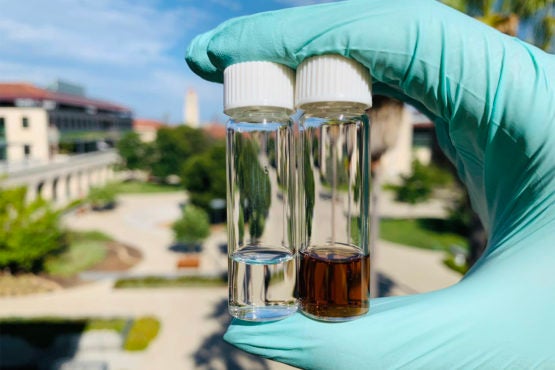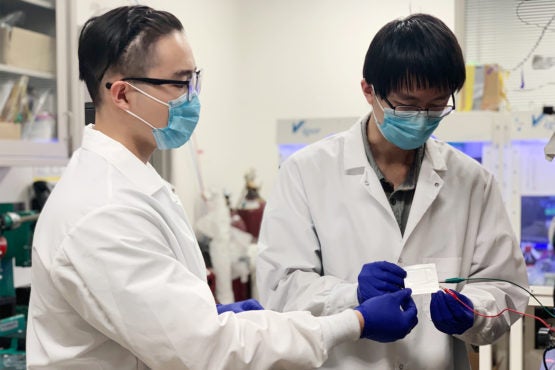New battery electrolyte developed at Stanford may boost the performance of electric vehicles
Stanford researchers have designed a new electrolyte for lithium metal batteries that could increase the driving range of electric cars.
A new lithium-based electrolyte invented by Stanford University scientists could pave the way for the next generation of battery-powered electric vehicles.

A conventional (clear) electrolyte on the left and the novel Stanford electrolyte of the right. (Image credit: Zhiao Yu)
In a study published June 22 in Nature Energy, Stanford researchers demonstrate how their novel electrolyte design boosts the performance of lithium metal batteries, a promising technology for powering electric vehicles, laptops and other devices.
“Most electric cars run on lithium-ion batteries, which are rapidly approaching their theoretical limit on energy density,” said study co-author Yi Cui, professor of materials science and engineering and of photon science at the SLAC National Accelerator Laboratory. “Our study focused on lithium metal batteries, which are lighter than lithium-ion batteries and can potentially deliver more energy per unit weight and volume.”
Lithium-ion vs. lithium metal
Lithium-ion batteries, used in everything from smartphones to electric cars, have two electrodes – a positively charged cathode containing lithium and a negatively charged anode usually made of graphite. An electrolyte solution allows lithium ions to shuttle back and forth between the anode and the cathode when the battery is used and when it recharges.

PhD candidates and lead authors Hansen Wang, left, and Zhiao Yu, right, testing an experimental cell in their laboratory. (Image credit: Hongxia Wang.)
A lithium metal battery can hold about twice as much electricity per kilogram as today’s conventional lithium-ion battery. Lithium metal batteries do this by replacing the graphite anode with lithium metal, which can store significantly more energy.
“Lithium metal batteries are very promising for electric vehicles, where weight and volume are a big concern,” said study co-author Zhenan Bao, the K.K. Lee Professor in the School of Engineering. “But during operation, the lithium metal anode reacts with the liquid electrolyte. This causes the growth of lithium microstructures called dendrites on the surface of the anode, which can cause the battery to catch fire and fail.”
Researchers have spent decades trying to address the dendrite problem.
“The electrolyte has been the Achilles’ heel of lithium metal batteries,” said co-lead author Zhiao Yu, a graduate student in chemistry. “In our study, we use organic chemistry to rationally design and create new, stable electrolytes for these batteries.”
New electrolyte
For the study, Yu and his colleagues explored whether they could address the stability issues with a common, commercially available liquid electrolyte.
“We hypothesized that adding fluorine atoms onto the electrolyte molecule would make the liquid more stable,” Yu said. “Fluorine is a widely used element in electrolytes for lithium batteries. We used its ability to attract electrons to create a new molecule that allows the lithium metal anode to function well in the electrolyte.”
The result was a novel synthetic compound, abbreviated FDMB, that can be readily produced in bulk.
“Electrolyte designs are getting very exotic,” Bao said. “Some have shown good promise but are very expensive to produce. The FDMB molecule that Zhiao came up with is easy to make in large quantity and quite cheap.”
‘Incredible performance’
The Stanford team tested the new electrolyte in a lithium metal battery.
The results were dramatic. The experimental battery retained 90 percent of its initial charge after 420 cycles of charging and discharging. In laboratories, typical lithium metal batteries stop working after about 30 cycles.
The researchers also measured how efficiently lithium ions are transferred between the anode and the cathode during charging and discharging, a property known as “coulombic efficiency.”
“If you charge 1,000 lithium ions, how many do you get back after you discharge?” Cui said. “Ideally you want 1,000 out of 1,000 for a coulombic efficiency of 100 percent. To be commercially viable, a battery cell needs a coulombic efficiency of at least 99.9 percent. In our study we got 99.52 percent in the half cells and 99.98 percent in the full cells; an incredible performance.”
Anode-free battery
For potential use in consumer electronics, the Stanford team also tested the FDMB electrolyte in anode-free lithium metal pouch cells – commercially available batteries with cathodes that supply lithium to the anode.
“The idea is to only use lithium on the cathode side to reduce weight,” said co-lead author Hansen Wang, a graduate student in materials science and engineering. “The anode-free battery ran 100 cycles before its capacity dropped to 80 percent – not as good as an equivalent lithium-ion battery, which can go for 500 to 1,000 cycles, but still one of the best performing anode-free cells.”
“These results show promise for a wide range of devices,” Bao added. “Lightweight, anode-free batteries will be an attractive feature for drones and many other consumer electronics.”
Battery500
The U.S. Department of Energy (DOE) is funding a large research consortium called Battery500 to make lithium metal batteries viable, which would allow car manufacturers to build lighter electric vehicles that can drive much longer distances between charges. This study was supported in part by a grant from the consortium, which includes Stanford and SLAC.
By improving anodes, electrolytes and other components, Battery500 aims to nearly triple the amount of electricity that a lithium metal battery can deliver, from about 180 watt-hours per kilogram when the program started in 2016 to 500 watt-hours per kilogram. A higher energy-to-weight ratio, or “specific energy,” is key to solving the range anxiety that potential electric car buyers often have.
Go to the web site to view the video.
“The anode-free battery in our lab achieved about 325 watt-hours per kilogram specific energy, a respectable number,” Cui said. “Our next step could be to work collaboratively with other researchers in Battery500 to build cells that approach the consortium’s goal of 500 watt-hours per kilogram.”
In addition to longer cycle life and better stability, the FDMB electrolyte is also far less flammable than conventional electrolytes, as the researchers demonstrated in this embedded video.
“Our study basically provides a design principle that people can apply to come up with better electrolytes,” Bao added. “We just showed one example, but there are many other possibilities.”
Other Stanford co-authors include Jian Qin, assistant professor of chemical engineering; postdoctoral scholars Xian Kong, Kecheng Wang, Wenxiao Huang, Snehashis Choudhury and Chibueze Amanchukwu; graduate students William Huang, Yuchi Tsao, David Mackanic, Yu Zheng and Samantha Hung; and undergraduates Yuting Ma and Eder Lomeli. Xinchang Wang from Xiamen University is also a co-author. Zhenan Bao and Yi Cui are senior fellows at Stanford’s Precourt Institute for Energy. Cui is also a principal investigator at the Stanford Institute for Materials & Energy Science, a joint SLAC/Stanford research program.
This work was also supported by the Battery Materials Research Program in the DOE Office of Vehicular Technologies. The facility used at Stanford is supported by the National Science Foundation.
To read all stories about Stanford science, subscribe to the biweekly Stanford Science Digest.
